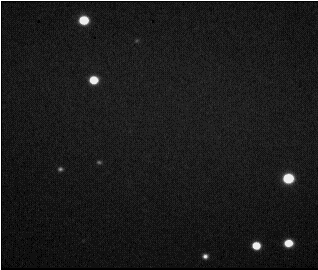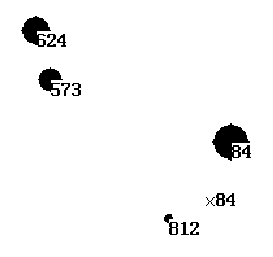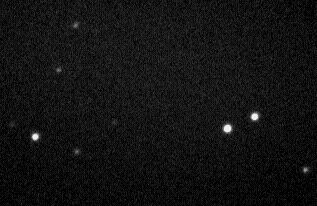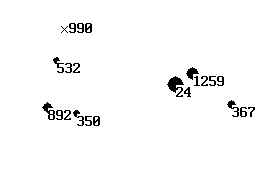Content
- Equipment
- Klio, October 14, 1996
- Yerkes, October 14, 1996
- Klio, Yerkes and Semiramis until November 14, 1996
- Determination of the Orbits
- Observatory on the Oldendorfer Berg,
Astronomische Arbeitsgemeinschaft Osnabrück,
(geographical latitude 52.254 deg, geographical longitude +8.324 deg (east of
Greenwich))
- Schmidt-Cassegrain system of 60cm diameter and focal length of about 7m
reduced by a shapley lense,
- ccd camera ST6 of S-Big,
- astronomy software
- Guide.40 for star maps and the exact positions of stars and
asteroids, the latter topocentric,
- Ceres for calculating precise geocentric positions of the
asteroids,
- image processing software MIRA and MiPS.
.
(back to the top)
We took several pictures of Klio on the Oldendorfer Berg between 19.15 UT and
20.15 UT. The exposure time was 20s. Two of the pictures are shown at the top
of the project description. In spite of the
short time difference the proper motion of the asteroid is clearly to be seen!
For clarity we superposed the both pictures so that the stars coincide:

 The both objects in the lower right edge are Klio moving retrograde.
The both objects in the lower right edge are Klio moving retrograde.
Comparison of the ccd pictures with the map calculated by Guide 4.0 let us
identify four of the stars in the pictures. The program then gave us the
geocentric equatorial coordinates:
- GSC 2329 624: alpha = 2h43m 1.624s, delta = 33d11'53.77"
- GSC 2329 573: alpha = 2h43m 0.434s, delta = 33d11'03.91"
- GSC 2329 084: alpha = 2h42m46.190s, delta = 33d10'02.24"
- GSC 2329 812: alpha = 2h42m51.110s, delta = 33d08'45.82"
Measuring of the observed topocentric positions had approximately the
following results (the results obtained with different programs differ
slightly!):
- 19:16:56 UT: alpha = 2h42m47.740s, delta = 33d09'00.874"
- 20:10:01 UT: alpha = 2h42m45.567s, delta = 33d09'06.748"
The calculated geocentric positions are
- 19:16:57 UT: alpha = 2h42m47.518s, delta = 33d09'06.54", r = 1.028148 AU
- 20:10:01 UT: alpha = 2h42m45.377s, delta = 33d09'11.67", r = 1.028072 AU
Evaluation of these results with our program gives the first preliminary values of
our own parallax of the sun:
- Combination of the observed topocentric with the calculated geocentric
position:
- 19:16:57 UT: pi(Sun) = 8.0"
- 20:10:01 UT: pi(Sun) = 7.8"
- Combination of both pictures: The motion of Klio is not only due to its
proper motion but is influenced by our own motion due to the earth's rotation
during 44 minutes (try to verify that our positions are seperated by ???? km
approximately!)!
- using the precise geocentric positions calculated by Ceres:
pi(Sun) = 9.6"
- using geocentric positions approximately calculated by means of our own
two body ephemeris calculation: pi(Sun) = 10.1"
Compared with the exact value pi = 8.794" all results of the first day
differ less than 15 percent! We are lucky especially about the value
resulting by combination of the two pictures: We got a quite good parallax
measure during less then one hour using only roughly calculated geocentric
positions.
If we are able to combinate simultanously taken pictures we will
need only the corresponding geocentric distance which can be calculated even
more easily.
(back to the top)
The picture below shows Yerkes at 19:29:26 UT.
As with Klio we compared the ccd image with an output of Guide.40:

 From these pictures we could identify the following stars:
From these pictures we could identify the following stars:
- GSC 1796 0532: alpha = 3h14m01.790s, delta = 29d07'42.31"
- GSC 1796 0892: alpha = 3h14m02.661s, delta = 29d06'42.48"
- GSC 1796 0350: alpha = 3h13m59.846s, delta = 29d06'33.98"
- GSC 1796 0024: alpha = 3h13m50.150s, delta = 29d07'12.36"
- GSC 1796 1259: alpha = 3h13m48.470s, delta = 29d07'25.90"
- GSC 1796 0367: alpha = 3h13m44.680s, delta = 29d06'45.79"
The result for the topocentric coordinates is:
alpha = 3h14m01.068s, delta = 29d08'24.108"
The calculated geocentric position is:
alpha = 3h14m00.793s, delta = 29d08'26.130", r = 1.275044 AU
From these values we can derive the following measure for the sun's parallax:
pi(Sun)=6.12". This value is not as good as for Klio. One reason may be
the fact that the stars have too similar declinations not allowing a good
astrometry.
This result is not very surprising for us: We know that the comparison of
only one measured topocentric position with the calculated geocentric position
is extremely sensitiv for errors!
(back to the top)
Today, we got the first contact to other groups. Therefore, we took the time to
test our procedures:
- Erwin Heiser of the Astronomische Arbeitsgemeinschaft Osnabrück took
several ccd images of Klio, Yerkes and Semiramis and made the
necessary astrometry.
- We tested the value of the results for deriving the sun's parallax and
tried to get first orbital elements from our own measurements.
We now have got images and positions for the following days:
- Klio: Oct. 14, Nov. 13, Nov. 14,
- Yerkes: Oct. 14, Nov. 8, Nov. 14,
- Semiramis: Nov. 8, 13, 14.
On November 8, we got different positions of Yerkes, seperated by approximately
100 min. By these values we were again able to determine the distance to the
sun (as described above). The best result:
pi(sun)=8.4arcsec
In this way, we are shure that the positions obtained at the Oldendorfer Berg
are precise enough (and perhaps more than this) for our goal.
Now we are hoping to make and to get images taken simultanously with those of
the observatory of La Silla, due to an observation
proposal of Osnabrück! To make it easier to find the asteroids we
give star maps in an additional paper.
(back to the top)
Klio
With the following topocentric positions
- Oct. 14, 1996, 19:17:07 UT: RA 2h42m47.740s, dec 33d 9' 0.874"
- Nov. 13, 1996, 20:14:06 UT: RA 2h 9m40.625s, dec 31d48' 8.617"
- Nov. 14, 1996, 18:26:40 UT: RA 2h 8m49.550s, dec 31d41'52.237"
(which we took as geocentric!) we got by means of the algorithm of Gauss the
following orbital elements:
a = 2.361, e = 0.241, i = 9.309, kl = 327.940
Semiramis
With the following topocentric positions
- Nov. 8, 1996, 21:20:27 UT: RA 2h43m41.376s, dec 34d45'50.301"
- Nov. 13, 1996, 20:27:58 UT: RA 2h39m 5.268s, dec 33d51'13.477"
- Nov. 14, 1996, 18:39:53 UT: RA 2h38m16.977s, dec 33d40'22.863"
(which we took as geocentric!) we got by means of the algorithm of Gauss the
following orbital elements:
a = 2.307, e = 0.241, i = 9.990, kl = 285.075
Yerkes
With the following topocentric positions
- Oct. 14, 1996, 19:29:36 UT: RA 3h14m 1.07s, dec 29d 8'24.11"
- Nov. 8, 1996, 21:03:06 UT: RA 2h49m35.70s, dec 29d38'27.92"
- Nov. 14, 1996, 18:01:09 UT: RA 2h43m20.97s, dec 29d25'57.00"
(which we took as geocentric!) we got by means of the algorithm of Gauss the
following orbital elements:
a = 2.672, e = 0.215, i = 8.771, kl = 354.277
All of these elements are in surprisingly good agreement with those we got from
Guide.40. Therefore, we will be able to calculate the necessary
ephemeris data by means of self measured and calculated orbital elements. We
hope that these data will be precise enouph, at least for the combination of
positions measured by different observatories!
(back to the top)
update: November 19, 1996





